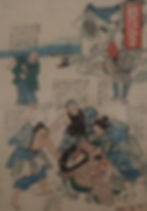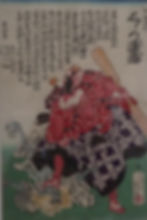Collection of Machida City Museum of Graphic Arts
- Michi
- 2022年4月25日
- 読了時間: 3分
更新日:2022年4月27日
The exhibition featuring 'Humor in Edo' was on view from Mar.12 to Apr. 10, 2022.
I visited the Museum the day before the final day. I was fascinated with the works that filled with political satires and a sense of humor.



The entrance of Machida City Museum of Graphic Arts
Walking up the marble stairs

The title of the woodblock print above is "He looks Fierce, but is Really a Nice Guy" by UTAGAWA Kuniyoshi (1797~1861). He depicted man's face formed by many naked men.
Under the Tenpo Reforms (1841~1845) which was aimed to ease economic crisis by controlling public displays of luxury and wealth, depicting beauties, actors, professional female entertainers, and so on in ukiyo-e was banned by the Tokugawa Shogunate. Consequently it became a kind of artistic challenge for Kuniyoshi to establish the new genre of ukiyo-e.
The print is from the collection by TAGAWA Suiho (田河水泡).

The title of the woodblock print above is "People Torturing a Catfish", from the collection by TAGAWA Suiho (田河水泡).
You see two women, who have been damaged by the Ansei Great Earthquake (安政の大地震), grabbing a cat fish by the collar and complaining that you are responsible for the big earthquake in 1855. The cat fish is apologizing by saying, "I'll never shake the earth again."
And you see a rich man encouraging them while a craftsman trying to break them up.
People used to believe that a catfish caused an earthquake.

The title of the woodblock print above is "Rabbit Beating Incarnation (化身) of measles",
by IKKOSAI Ikumaru (一交斉幾丸). It is a parody picture depicting a kabuki play "Tiger killing by WATONAI (和藤内)".
Since having a pet rabbit gained popularity in 1873 ( Meiji 4), the price has reached its peak in 1873 (Meiji 6). Consequently pet rabbits became investment targets.

The woodblock print above is otsu-e (大津絵) which was a folk art that began in the district of Otsu, a port of Lake Biwa, Shiga prefecture in the 17th century. Villagers there have developed the tradition of simple and unsophisticated depictions that were displayed for sale on the roadside stalls.
Buddhist illustrations were common and gradually changed to satirical drawings(風刺画), where demons often appeared as motif. Otsu-e has influenced ukiyo-e artists in the late Edo era.

The title of the woodblock print above is "Children at Play: Enjoying Fireworks", produced in 1868, from the collection by TAGAWA Suiho ( 田河水泡). It was a satirical drawing(風刺画) of the Boshin War (Japan's last civil war) which led to the Meiji Restoration. Judging from patterns on the children's kimono, you'll see the players of the Tokugawa Shogunate alliance, the last shogun Yoshinobu, and young Kazunomiya on the step-mother'back on the right, while those of new government forces and a young emperor on the man's back on the left.

The title of the woodblock print above is "Comical Scenes in Tokyo: "A Swiftly Darting Rickshow"(矢をつく車) produced in 1895 (Meiji 28) by KOBAYASHI Kiyochica (小林清親). You'll understand how much this geisha or the professional female entertainer was in a hurry. Looking at her face, you'll get the feeling of speed.

The title of the woodblock print above is "Thirty-six Amusing Views of Famous Places of Tokyo; Nihonbashi, by SHOSAI Ikkei (昇斉一景) in 1872 (Meiji 5). A driver of the Rickshow accidentally slipped up the waste (糞尿). Ikkei loved to depict humorously people's life in Edo in the early Meiji period (1868~1912).
For more information: please access 町田国際版画美術館.



